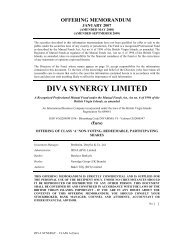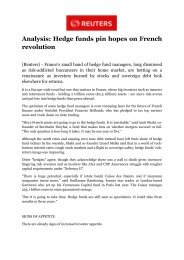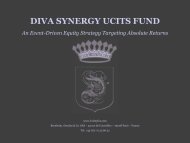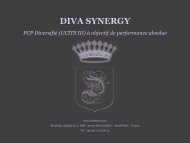DIVA SYNERGY UCITS FUND - Bernheim, Dreyfus & Co.
DIVA SYNERGY UCITS FUND - Bernheim, Dreyfus & Co.
DIVA SYNERGY UCITS FUND - Bernheim, Dreyfus & Co.
Create successful ePaper yourself
Turn your PDF publications into a flip-book with our unique Google optimized e-Paper software.
Structure of Portfolio<br />
Market Volatility<br />
Investment Strategy<br />
The investment strategy revolves around two pillars: Announced Merger Arbitrage (announced deals) and<br />
Pre-Event Merger Arbitrage (anticipated deals)<br />
Portfolio Structure<br />
1. Announced Merger<br />
Arbitrage<br />
• Announced M&A Deals<br />
2. Pre-Event Merger<br />
Arbitrage<br />
• Identify potential M&A<br />
targets<br />
• To achieve the target return and volatility, the allocation between<br />
the two strategies is adjusted depending on the economic cycle<br />
and market conditions<br />
• 40 to 50 stocks listed in Western Europe and North America<br />
• Market fluctuations systematically covered (Market-Neutral)<br />
Portfolio Allocation<br />
• The structure of the portfolio and the allocation between the<br />
two strategies Pre-Event Merger Arbitrage and Announced<br />
Merger Arbitrage depends mainly on the level of volatility in<br />
the market. Higher market volatility results in higher risks<br />
which gives larger spreads and therefore makes the<br />
Announced Merger Arbitrage strategy more profitable than<br />
the Pre-Event Merger Arbitrage .<br />
• As illustrated below there is a clear correlation between the<br />
structure of our portfolio and the market volatility. At the<br />
end of 2008 when volatility – in terms of the VIX (1) index –<br />
was above 40 more than 90% of the portfolio (managed by<br />
the same team, applying the same strategy) was invested in<br />
the Merger Arbitrage strategy.<br />
Historical Portfolio Allocation - (managed by the same team, applying the same strategy)<br />
Pre-Event Driven Portfolio Merger Arbitrage Portfolio VIX<br />
100%<br />
80%<br />
60%<br />
40%<br />
20%<br />
0%<br />
Q1<br />
2007<br />
Q2<br />
2007<br />
Q3<br />
2007<br />
Q4<br />
2007<br />
Q1<br />
2008<br />
Q2<br />
2008<br />
Q3<br />
2008<br />
Q4<br />
2008<br />
Q1<br />
2009<br />
Q2<br />
2009<br />
Q3<br />
2009<br />
Q4<br />
2009<br />
Q1<br />
2010<br />
Q2<br />
2010<br />
Q3<br />
2010<br />
Q4<br />
2010<br />
Q1<br />
2011<br />
Q2<br />
2011<br />
60<br />
50<br />
40<br />
30<br />
20<br />
10<br />
0<br />
(1) An indicator of U.S. financial markets volatility. The index is calculated by averaging the volatilities on put and call options on the S&P500.<br />
5






